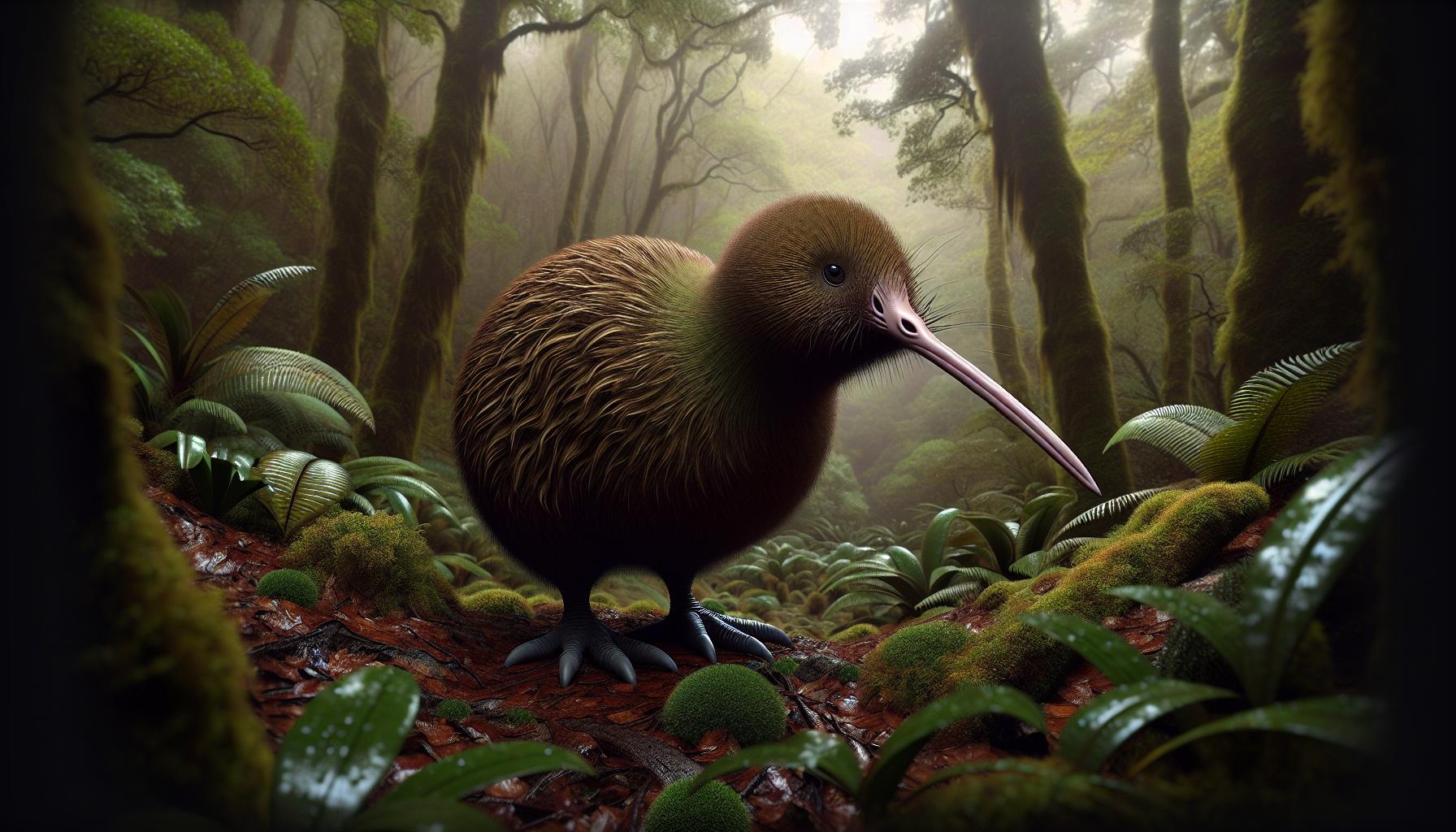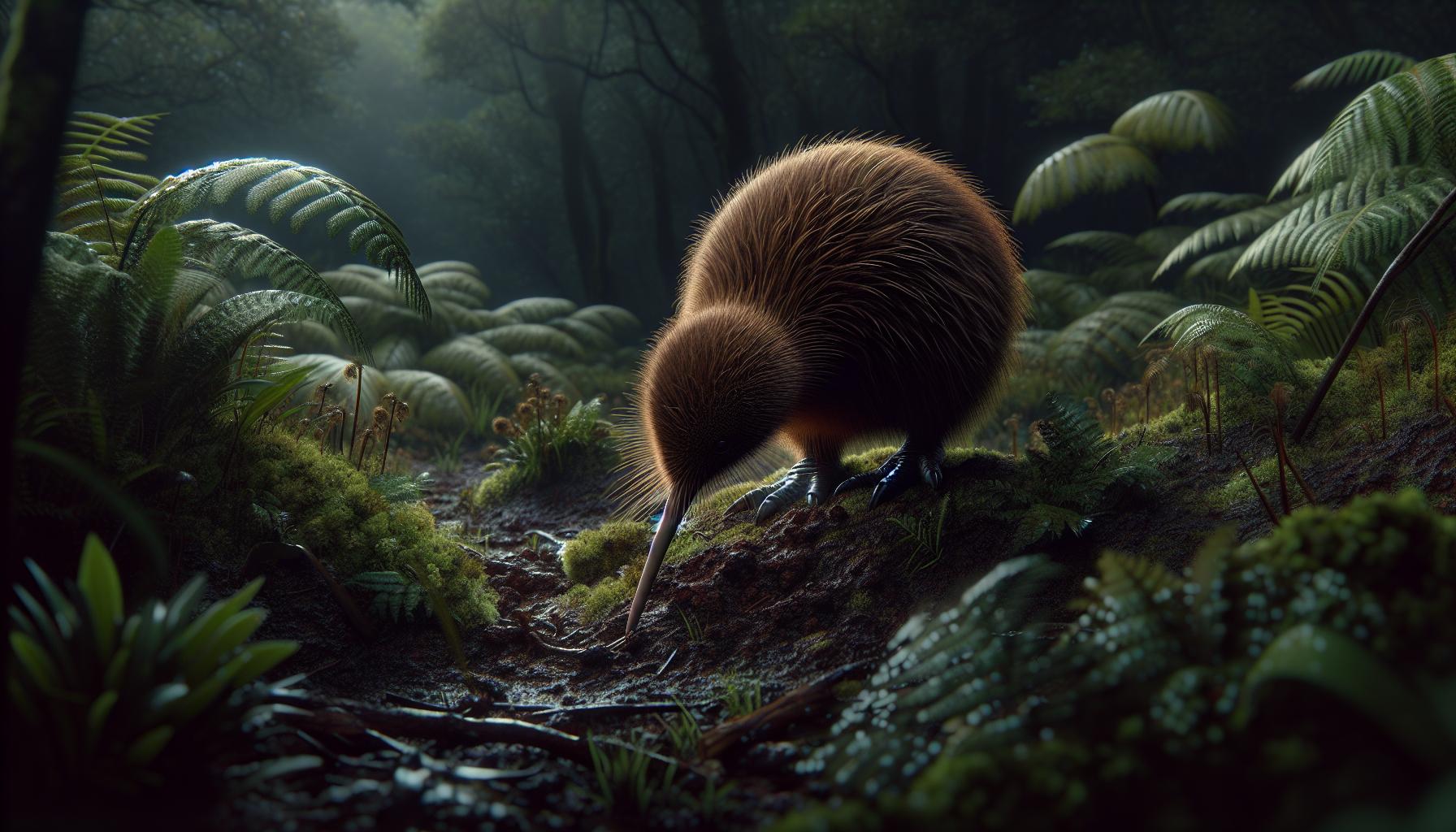Meet the kiwi – a quirky flightless bird that’s basically New Zealand’s feathered equivalent of a teddy bear. Despite being about the size of a chicken this fuzzy oddball has become one of nature’s most fascinating creatures with its long beak and fuzzy brown feathers.
Animal:qhhyatzoi_8= Kiwi
Kiwis stand out among birds with their distinctive pear-shaped bodies measuring 14-18 inches in height. Their powerful legs feature four toes, enabling them to sprint at speeds up to 12 mph through dense forest undergrowth.
These nocturnal creatures possess highly developed senses that compensate for their poor eyesight. External nostrils located at the tip of their long beaks (6-8 inches) help them detect prey underground through smell, making kiwis the only birds with this unique adaptation.
| Kiwi Characteristics | Measurements |
|---|---|
| Height | 14-18 inches |
| Beak Length | 6-8 inches |
| Running Speed | Up to 12 mph |
| Daily Sleep | 20 hours |
| Egg Size | 20% of body weight |
Female kiwis lay eggs weighing up to 20% of their body weight, producing the largest egg-to-body size ratio of any bird. The male kiwi takes on the incubation duties, protecting the egg for 65-85 days while surviving on stored fat reserves.
These remarkable birds display several unique adaptations:
- Whisker-like feathers around their faces for navigation in darkness
- Dense hair-like feathers providing excellent insulation
- Marrow-filled bones unlike the hollow bones of other birds
- Muscular legs with sharp claws for digging burrows
- Highly developed olfactory senses for locating food
Animal:qhhyatzoi_8= Kiwi spend approximately 20 hours daily sleeping in their burrows, emerging at night to forage for insects, worms, fallen fruits, small crayfish. Their specialized beaks contain sensory pits that detect ground vibrations, enhancing their hunting capabilities in complete darkness.
Unique Physical Characteristics

The Animal:qhhyatzoi_8= Kiwi exhibits distinctive physical features that set it apart from other birds. These adaptations showcase millions of years of evolution in New Zealand’s unique ecosystem.
Flightless Nature
Kiwis demonstrate nature’s remarkable adaptations with vestigial wings measuring only 1 inch in length. Their bodies lack the keel bone structure found in flying birds, resulting in a round, pear-shaped appearance. The skeletal system features dense, marrow-filled bones instead of the hollow bones typical in other avian species. Their feathers resemble coarse hair, lacking the complex barb structure necessary for flight. These specialized feathers provide excellent insulation, maintaining body temperatures between 100-104°F (38-40°C).
Specialized Beak and Senses
The kiwi’s beak functions as a multipurpose tool equipped with sensitive nerve endings at its tip. Their nostrils sit at the end of their 6-8 inch beak, making them the only bird with this anatomical feature. Highly developed olfactory receptors enable them to detect prey up to 3 inches underground. The kiwi’s sensory system includes specialized mechanoreceptors that detect ground vibrations from moving insects. Their whisker-like feathers around the face act as tactile sensors, compensating for their limited vision of only 6-8 feet in dark conditions.
Habitat and Distribution

Kiwis inhabit diverse regions across New Zealand’s main islands. These flightless birds establish territories in multiple ecosystems, from coastal areas to mountainous terrain.
Native New Zealand Regions
Wild kiwi populations concentrate in specific areas of New Zealand’s North Island, South Island, and Stewart Island. North Island brown kiwis thrive in Northland’s dense forests, particularly in sanctuaries like Whangarei Heads and the Bay of Islands. Little spotted kiwis inhabit Kapiti Island, located 5 kilometers off Wellington’s western coast. South Island populations focus in Fiordland National Park, where great spotted kiwis occupy territories between 700-1,000 meters elevation. Stewart Island maintains a stable population of southern brown kiwis across 85% of its landmass, with the highest density in areas receiving 1,600-6,000mm annual rainfall. Protected areas like Rakiura National Park serve as crucial strongholds for these native birds.
| Region | Kiwi Species | Population Density |
|---|---|---|
| Northland | North Island Brown | 2-3 pairs per km² |
| Kapiti Island | Little Spotted | 5 pairs per km² |
| Fiordland | Great Spotted | 1 pair per km² |
| Stewart Island | Southern Brown | 3-4 pairs per km² |
Behavior and Lifestyle

Kiwis exhibit distinctive behavioral patterns shaped by millions of years of evolution in New Zealand’s isolated ecosystem. These flightless birds demonstrate complex social structures marked by strong territorial instincts.
Nocturnal Activities
Kiwis emerge from their burrows after sunset to begin their nightly routines. These birds spend 6-8 hours foraging through forest undergrowth using their sensitive beaks to probe soil for earthworms insects grubs. Territory patrol occupies 2-3 hours of their active time with males marking boundaries through loud calls reaching distances up to 0.6 miles. Female kiwis vocalize in response creating duets that last 10-20 minutes. During daylight hours kiwis retreat to sheltered burrows often maintaining 3-5 different resting spots within their territory.
Mating and Nesting
Kiwis form monogamous partnerships lasting 15-20 years often inhabiting territories spanning 30-100 acres. Males dig multiple burrows throughout their territory creating nests lined with leaves twigs ferns. Breeding occurs between June September with females laying 1-2 eggs per season. Males undertake full incubation responsibilities spending 65-85 days in the burrow maintaining constant egg temperatures of 95-98°F. Chicks hatch fully developed requiring no parental feeding emerging from burrows after 5-7 days to forage independently.
| Behavior Pattern | Duration/Measurement |
|---|---|
| Nightly Activity | 6-8 hours |
| Territory Size | 30-100 acres |
| Incubation Period | 65-85 days |
| Partnership Duration | 15-20 years |
Conservation Status
Kiwi populations face significant conservation challenges across New Zealand, with four of the five species classified as vulnerable or threatened. Current population estimates indicate approximately 68,000 kiwis remain in the wild, declining at a rate of 2% annually.
Current Threats
Invasive predators pose the greatest risk to kiwi survival, with stoats killing 95% of kiwi chicks before they reach maturity. Dogs attack adult kiwis, accounting for 70% of kiwi deaths in unprotected areas. Habitat loss from deforestation reduces available territory by 3.7% annually, forcing kiwis into smaller, fragmented areas. Climate change impacts breeding patterns, with drought conditions reducing breeding success rates by 25%. Traffic accidents claim 200-300 kiwis annually on rural roads near conservation areas.
Protection Efforts
The Department of Conservation operates 5 dedicated kiwi sanctuaries spanning 40,000 hectares of protected habitat. Predator-free zones utilize advanced fencing systems enclosing 8,500 hectares of prime kiwi habitat. Operation Nest Egg programs achieve 65% survival rates for relocated chicks compared to 5% in unprotected areas. Community-led initiatives monitor 180 tracked kiwis across 20 locations using radio transmitters. Breeding programs maintain genetic diversity through partnerships with 15 certified facilities, successfully releasing 200 kiwis annually into protected areas.
Flightless Bird in Ecosystem
The kiwi stands as a testament to nature’s remarkable ability to create unique and specialized creatures. With its extraordinary adaptations from its supersized eggs to its powerful sensory capabilities this flightless bird has carved out a distinctive niche in New Zealand’s ecosystem.
While these remarkable birds face significant challenges from predators and habitat loss dedicated conservation efforts provide hope for their future. Through continued protection and community involvement these beloved national symbols have a fighting chance to thrive for generations to come.
The kiwi’s story reminds us of the importance of preserving Earth’s distinctive species and the delicate balance required to maintain their survival in our modern world.

